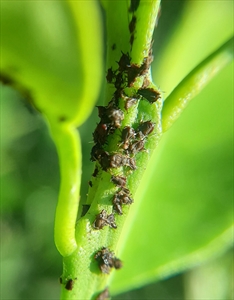- Chillies are grown world-wide. There are many varieties and they differ in ‘hotness’.
- Active ingredient is Capsaicin. The common varieties have a range of ‘hotness’ [measured in Scoville heat units (SHU)], e.g.:
- Habanero (Red Savina) = 350,000 to 750,000 SHU.
- Habanero (Fiji Bongo Chili) = 100,000 to 350,000 SHU
- Nepalese Akabare = 100,000 to 350,000 SHU
- Bird’s Eye = 50,000 to 100,000 SHU.
- Formulation guide:
- Bird’s Eye – 20g/L fresh weight (about 30 ripe fruits)
- Bongo chili/Akabare – 10g/L fresh weight (about 5 ripe fruits)
- Red Savina – 5g/L fresh weight (about 3 ripe fruits).
- Must use personal protection equipment (PPE) when preparing the chillies and spraying:
- Collect mature to ripe fruits of selected chili variety.
- Crush and pound the chilies, working them into a paste.
- Place the paste on a fine muslin cloth and bring the sides together making a cloth bag enclosing the paste. Place the cloth bag in a bucket adding sufficient water to cover the bag for at least 1 hour, preferably overnight.
- After soaking, squeeze the juice from the bag with hands protected by rubber gloves or plastic bags.
- For each 1L water of the final mix, add 10ml (1 bottle cap) cooking oil and 5g (1/2 bottle cap) bar soap (preferably vegetable Castile soap).
- Check to see if the mix contains plant material which might block the sprayer. If it does, strain through fine muslin or a metal strainer.
- Add water to achieve final volume; pour into the sprayer, and use.
- Adapt formulation to 10L or 15L mixture to fit hydraulic knapsack sprayer.
- Used to control aphids on a range of vegetable crops, thrips on eggplant, and to disrupt the symbiotic relationship between ants (e.g., white-footed ant), aphid and scale insects, particularly Icerya seychellarum.










